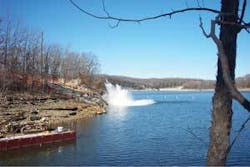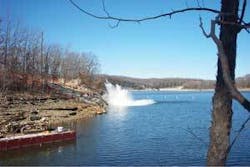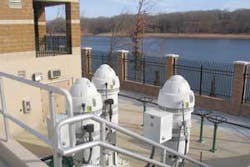Innovative engineering helps meet rising water demands in NW Arkansas
Extensive geotechnical investigations led MWH Global to complete the Beaver Water District Raw Water Intake Project on time and under budget -- and minimize risk.
Picturesque Beaver Lake, boasting 487 miles of natural shoreline with limestone bluffs, caverns and lush forests, is more than a popular recreation and tourist destination in the Ozark Mountains of Northwest Arkansas. The lake provides a crucial drinking water source for the area’s cities, which have grown rapidly for more than a decade, propelled by an ongoing economic boom fueled by locally based multinationals -- Tyson Foods and Wal-Mart.
Now one of the nation’s fastest-growing areas, Northwest Arkansas currently adds some 1,000 new residents monthly, and recent studies project that it could become home for as many as 1.2 million people by 2055.
Beaver Lake was created in the mid-1960s when the US Army Corps of Engineers built Beaver Dam as a hydropower project at the White River’s origin near Eureka Springs. The first raw water intake facility on the lake and an associated water treatment plant also were built at that time. Beaver Water District, the owner and operator of those facilities, was formed to pay for the lake’s drinking water supply allocation and to act as environmental steward for the lake and its vital watershed.
Since that time, the district has expanded and improved the original intake and treatment plant, and added and expanded a second plant to stay ahead of increasing drinking water demands and standards. The district wholesales drinking water to the cities of Bentonville (home to Wal-Mart), Fayetteville (home to the University of Arkansas), Rogers and Springdale (home to Tyson Foods). These cities then resell the water to residential, commercial, and industrial customers. Currently, the district’s 100-million-gallon-per-day (mgd) capacity provides drinking water for nearly a quarter-million people throughout Northwest Arkansas, more than nine percent of the state’s population.
During peak water usage periods, however, the district’s facilities operated at maximum capacity. Water demand projections in 2001 indicated that instantaneous summertime diversions could exceed 80 mgd by 2005, normal water demand could exceed 140 mgd by 2020, and build-out conditions could create a water demand of 220 mgd by 2050.
To ensure drinking water supplies capable of meeting this fast-growing demand well into the future, the District undertook an US$ 84.2 million Facilities Expansion Program in 2002. A critical component was a new Raw Water Intake facility at Beaver Lake, with a 140-mgd, 10,000 horsepower pump station, to be completed by July 2005. The new intake facility posed significant engineering and construction challenges, not the least of which was the requirement to build all or part of it in or adjacent to a lake full of water, and on a fast-track schedule.
The original intake had been built on the White River’s limestone bluffs before the dam was completed and before the lake was filled. Designed to allow diversion of raw water from varying depths within the soon-to-be-filled lake, the vertical, multi-port intake structure was built “in the dry” using conventional engineering and construction methods, including an extensive drill-and-blast approach for reshaping the limestone bluffs. While the new Raw Water Intake also would require a multi-level facility with capability for 90-feet-deep withdrawal from the lake, building it completely or partially “in the wet” required a much more innovative approach.
For help in meeting such challenges, Beaver Water District contracted with MWH Global Inc., an international engineering consulting firm with more than 20 years’ experience helping the district expand and improve its facilities. For the new Raw Water Intake project, MWH provided preliminary planning, detailed design plans and specifications, construction management and start-up services. MWH subcontracted with Fayetteville-based McGoodwin, Williams and Yates (MWY) for architectural, civil and structural design and construction management support, and with Sacramento-based Bennett/Staheli Engineers for geotechnical design and construction management services.
Assessing alternatives and risk
During preliminary planning, four alternative construction methods were considered:
• Building the intake within a cofferdam to permit “in the dry” construction.
• Prefabricating major components and then placing them within the lake “in the wet.”
• Building deep intake shafts at the shore/lake interface along with an intake channel to the lake, requiring extensive drill-and-blast construction at the shoreline.
• Building two deep intake shafts set back from the shore/lake interface, along with microtunneled pipelines to the lake.
The fourth alternative was chosen. Two 30-feet-diameter, 95-feet-deep intake shafts would be built 200 feet back from the shore/lake interface, along with eight, 60-inch-diameter microtunneled pipeline connections to the lake, and a ninth, 60-inch-diameter microtunneled pipeline to interconnect the two intake shafts.
This approach offered Beaver Water District the most favorable cost/risk combination while minimizing both drill-and-blast construction and disruption to the lake’s ecology and environment. Also, placing the intake shafts onshore and locating the mechanical and electrical equipment and housing superstructure some distance from the shore/lake interface ensured equipment security while helping preserve the beauty of the lake’s scenic natural shoreline.
Using a microtunnel boring machine to create the eight microtunneled pipelines into the lake posed inherent risks because of the need to guide and push it through karstic limestone, which is, by nature, replete with solution cavities, cracks, crevices, cuts, fissures and fractures. Moreover, there was another inherent risk in the required underwater retrieval of the machine: underwater retrieval of a microtunnel boring machine had been accomplished on only two previous US projects for 30-inch-diameter tunnels, but had never before been attempted for 60-inch-diameter tunnels.
During the design phase, MWH conducted geotechnical investigations of two potential sites in order to classify the general geology and determine site-specific risks. The selected site was 700 feet downstream from the lake’s original intake, chosen because it provided relatively consistent limestone formation and shorter microtunnel drive lengths.
Innovative engineering minimizes risk
“To help minimize risk, we performed an intensive, thorough drilling program to better understand the irregularities of the limestone before any construction work was begun,” recalled MWH Project Manager Don Spiegel, P.E.
Such investigations led the team to use a number of innovative approaches and techniques throughout the project:
• They chose the construction method with the lowest need for blasting volume, which in turn reduced risk to personnel and equipment, and protected the lake’s ecology and environment.
• After using drill-and-blast techniques to excavate 90 feet of hard limestone and shale for the two intake shafts and removing the blast rock, they shored the shaft walls with rock anchors and shotcrete to offset the potential for falling rock and to channel and control any found groundwater. A poured-in-place, reinforced concrete liner provided a smooth, finished surface inside the shafts. The shafts served two important functions: 1) as temporary launch shafts for the microtunnel boring machine during construction; and 2) as the permanent wet wells for the vertical turbine pumps that would lift lake water into a new 60-inch-diameter pipeline to carry it to the District’s water treatment plant two miles away.
• They judiciously selected locations and elevations for the microtunnels to provide necessary variable diversion depths and to place each microtunnel completely within one of the area’s two geology types, either St. Joe’s Limestone formation or Chattanooga Shale formation.
• They performed minor underwater “bench” blasting near the lake at microtunnel intake pipeline locations to remove weathered rock possibly containing karstic limestone, unfilled solution cavities and fractures. This “dental” blasting also created underwater ledges that helped facilitate boring machine retrieval.
• They used air pressure to gently push the boring machine into the lake to complete the required eight microtunnel bores, then achieved underwater retrieval of the machine at each bore by using a closure bulkhead at the rear of the machine and a large crane to lift the machine from the lake back onto shore.
• They chose to place the intake facility 200 feet back from the shoreline to allow better security of the site with perimeter fencing, and a more visually pleasing blending of the facility into the surrounding landscape for minimal impact on the lake’s natural shoreline.
“Minimizing the blasting volume, ensuring microtunnel success via extensive geotechnical investigations and placing the facility back from the shoreline helped achieve the proper risk management for the project,” noted Spiegel.
Project wins ACEC award
The project was completed on time, with operations beginning in July 2005, and came in nearly US$ 4 million under budget, while providing valuable lessons for the engineering community. First, MWH demonstrated that karstic limestone can be microtunneled successfully with proper consideration of risk and with planning that avoids open solution cavities and major fractures and places microtunnel bores completely within a particular geological formation. Second, relatively large microtunnel boring machines can be retrieved successfully underwater with proper planning and execution. Third, an intake structure with variable withdrawal levels can be successfully placed some distance from a lake shoreline, minimizing environmental disruption and providing enhanced security and aesthetics.
According to Spiegel, the project’s significant under-budget delivery was largely the result of extremely thorough planning and design. “The level of detail provided in the plans and specifications resulted in highly competitive construction bids and change orders below one percent of the bid amount,” he explained.
The design, construction and start-up of the Beaver Lake Raw Water Intake facility were the results of a collaborative effort among Beaver Water District, MWH, MWY and Bennett/Staheli Engineers. Earlier this year, the project earned the team an Engineering Excellence Award and Grand Conceptor Award from the Arkansas Section of the American Council of Engineering Companies (ACEC), and will now be considered for the national awards. The ACEC Grand Conceptor Award recognizes the overall best engineering achievement in the state.
Authors’ Note
Amy L. Wilson, the director of public affairs for Beaver Water District, can be reached by email: [email protected]. Connie Kafka is a freelance writer based in Palm Desert, California, USA.



